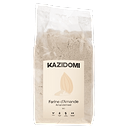Organic almond flour ticks all the boxes: gluten‑free, rich in good fats, and low in glycemic index. A healthy alternative to wheat flour, it deserves wider recognition. Behind its soft taste lies a dense, balanced nutritional profile. Discover why it holds its place in your pantry—and how to use it daily.
Naturally gluten‑free and easily digestible
Almond flour is made from blanched almonds finely milled at low temperature. Unlike industrial flours, it contains no additives or texturizers and is naturally free from gluten. Hence, it's ideal for people with gluten intolerance or for those avoiding refined flours for digestive reasons. With low antinutrient content, it’s also gentle on digestion and supports gut health.
A nutritional superstar
The main appeal of almond flour lies in its nutritional richness. It’s high in monounsaturated “good fats,” particularly oleic acid, known for its heart‑protective properties. It’s also a good source of plant protein—about 20 g per 100 g—significantly more than most cereal flours ([almonds.com][1]).
Micronutrients include vitamin E, a powerful antioxidant; magnesium, essential for energy metabolism and stress regulation; potassium, helpful in acid‑base balance; and calcium, beneficial when dairy consumption is limited ([Artinci][2]).
Low in carbohydrates, low glycemic index
Almond flour stands apart with very low carbohydrate content and a minimal glycemic index—typically under 1—making it especially compatible with keto, low‑carb, anti‑inflammatory, or diabetic diets. It supports stable blood sugar levels without spikes, while retaining a moist texture and pleasant flavor ([Milk & Honey Nutrition][3]).
Summary
Almond flour is far more than a health food trend—it’s a nutrient‑dense, digestible, and satisfying flour. Highly versatile, it can seamlessly replace traditional flours in everyday recipes. It’s the ideal ingredient for athletes, gluten-sensitive individuals, vegetarians, or anyone seeking balanced nutrition.

